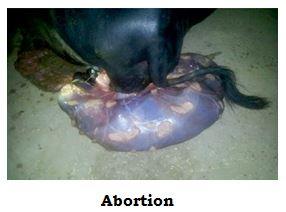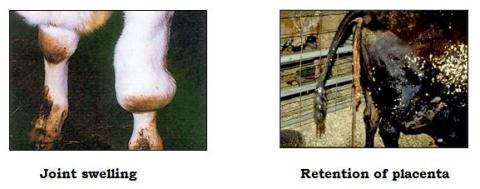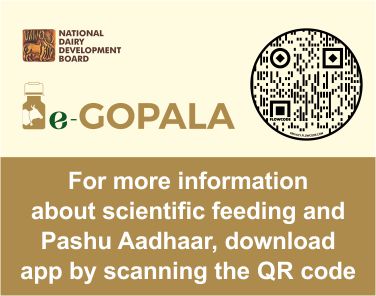
- An important bacterial disease of cattle and buffalo.
- Leads to loss in milk production, loss of calf, birth of weak or diseased calf ,repeat breeding and even mastitis.
- Humans may also get the disease from consumption of raw milk of infected animal or contact with uterine discharges.
- The disease is very much prevalent in India, both in humans and animals.
SYMPTOMS
- Abortion occurs typically after 5th month of pregnancy.
- In an infected animal, chances of abortion reduces with number of calvings.
- No abortions may be observed after 4th calving, but dam and calf remain infected.
- Placental retention may lead to infection and even death of the animal.
PREVENTION
- Vaccinate female calves (not male calves) between 4-8 months of age.
- Only one vaccination is required in its lifetime to protect it from brucellosis.
- Any abortion from 5th month onwards should be suspected for brucellosis.
- Ideally infected animals should be culled. If culling is not possible, isolate the animal immediately for a minimum of 20 days after calving/abortion.
- The aborted foetus, placenta, contaminated bedding, feed etc, should be buried (at least 4 feet deep) after a liberal sprinkling of lime. These materials contain very high bacterial loads and if disposed improperly cause the spread of disease by contaminating food sources (pasture, feed, water etc).
- Disinfect the shed after isolating the aborted animal.
- When the animal is in isolation, disinfect the lochial discharges (which also contain high bacterial loads) daily with 1-2% NaOH or 5% sodium hypochlorite (bleach) solution till the discharges cease (usually by 10 –15 days).
- Do not handle infected material with bare hands since the disease is zoonotic.
TREATMENT
- There is no effective treatment once the animal is infected since the bacteria remains in the body of the animal. Consult a veterinarian in case of suspicion.
- Disease in humans is curable provided proper regimen is followed.
Vaccinate 4-8 month old female calves once -protect them for life.

